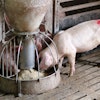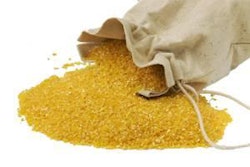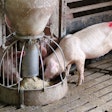Much of the work in the feed industry focuses around the mixture of ingredients – many of which are powders. Each powder has different physical properties, such as particle size, that pose unique challenges. A compromise needs to be found between plant productivity, cost, the homogeneity of the mix with feed, environmental and worker safety. The latter is of major significance since the use of a product does not guaranty its innocuousness and could pose long-term problems. Such is the case for nanomaterials, which are increasingly being used due to their modified properties (e.g. reactivity) in comparison to their bulk equivalent.
Methodologies for evaluating the properties of nanomaterials are still in development, and some scientific literature shows a discrepancy between the supplier product specifications and product assessment results. This article explores the issues surrounding nanomaterials in the feed mill and how high-tech measurement systems can work to improve the safety of the finished feed.
Nanomaterials within a regulatory framework
The European Union has recently agreed on the official definition of nanomaterials as “a natural, incidental or manufactured material containing particles, in an unbound state or as an aggregate or as an agglomerate where, for 50 percent or more of the particles in the number size distribution, one or more external dimensions is in the size range 1 to 100 nanometers. In specific cases where warranted by concerns for the environment, health, safety or competitiveness, the number size distribution threshold of 50 percent may be replaced by a threshold between 1 and 50 percent.”
This distinction becomes especially critical when the safety of a nanomaterial is being weighed under the Guidance of the European Food Safety Authority (EFSA). In Europe, all requests for the authorization of feed additives must accurately describe the user safety implications of the finished product. EFSA Panel on Additives and Products or Substances used in Animal Feed (FEEDAP) defines a user as the person(s) who may be exposed to the additive while incorporating it into premixtures or feedstuffs or while using a feedstuff supplemented with the additive.
It states: “An assessment of risk to users/workers should be included based on toxicological studies relevant to the nature of the additive. Experience in the manufacturing plant may be an important source of information in evaluating the risks to workers from exposure to the additive itself by both airborne and topical routes.”
In addition, acute inhalation toxicity studies should be performed if the additive contains more than 1 percent on a weight basis of particles with a diameter less than 50 micrometers. The particle size should be measured by laser diffraction; the means or medians should be expressed in relation to volume; and the material’s dusting potential should also be measured following recognized methods.
Dust: the old term for nano?
Nano powders in the workplace aren’t a new phenomenon – as they were already present in the form of dust. Anybody who has visited a feed mill can attest to the visible dust on the equipment and in the plant. Dust can have a negative effect on the equipment (due to abrasive effects); on animal health with the risk of cross contamination; on plant cleanliness; and on human health.
Workers (and to a lesser extent, farmers) may face toxicity due to skin contact, ingestion or inhalation of these particles. In practice, the highest risk for workers in premix and feed plants comes from the inhalable fraction of powders.
According to the FEEDAP, “The use of personal protective devices shall only be regarded as a measure of last resort to protect against any residual risk once control measures are in place. It is preferable, for example, to consider reformulation of the product.”
This explains what happened in 2011 when a new source of copper was submitted to the EU authorities. Most of the dossier was considered complete, but the manufacturer had to resubmit another request based on a diluted product. The initial finished product was considered too fine – almost all particles were below 100 micrometers with nearly three-quarters below 50 micrometers and about 2 percent below 10 micrometers. As a result, the dusting potential was judged as extremely high. The reformulated product, diluted on a carrier, showed no particles of the critical fraction (<50 micrometers), and the dusting potential was 0.03 g/m3 air. EU authorities scrutinize not only the active substance, but also the physical form of the final product that is submitted for application.
The need for analytical tools able to furnish this kind of information is especially important when nanomaterials are involved. Indeed, as shown by the study of 30 additives by Tecaliman, a private French technical center, the smaller the median diameter, the higher the dust emissions. As a consequence, smoother analytical devices are required.
Analytical methods to characterize engineered nanomaterials
Basic techniques to characterize powders used in the feed industry include particle size distribution (i.e. dry sifting for large particles and laser diffraction for smaller particles) and dust content (e.g. the Stauber-Heubach method). However, these procedures cannot be used for particles with diameters lower than one micrometer, which is too high for nanomaterials characterization. In these cases, analytical methods able to evaluate smaller particles are required.
In the context of nanomaterials, size is not the only parameter to take into account. The Guidance on the Safety Assessment of Nanomaterials (SCCS/1484/12) from the European Commission clearly explains that a better characterization of nanomaterials or engineered nanoparticles involves the determination of size distribution, shape, structure, chemical composition, agglomeration state, etc. (Figure 1). The evaluation of such parameters is important because they have been found to directly drive mobility, availability, interaction with surrounding medium and the capability of cell internalization of submicron particles. To fully characterize those nanomaterials at the occupational safety and hygiene level, as well as at the finished products level, different analytical tools exist.
Imaging techniques were among the first analytical tools to be utilized in nanotechnology for the evaluation of size, shape and structural information of nanomaterials. These techniques have been widely used to analyze milk-protein-based nanotubes, serum albumin and inorganic nano-sized contaminants in food products; however, the study of particles in the nanometer range requires powerful, expensive and time-consuming microscopic techniques.
Separation techniques are widely used to isolate nanomaterials (by size or mass) from the rest of the sample. The hyphenation of such techniques (SEC, FFF, CE) with size (SLS, DLS) or elemental detectors (ICP MS) offer powerful benefits for the physicochemical characterization of nanometric materials such as the size, shape and elemental composition of: aluminum, silicate, titanium or zinc nanoparticles; virus like particles and proteins or liposomes in polishing slurries; and final drug products. These multidimensional analytical strategies are intrinsically capable of providing rapid and accurate global mapping of the sample (Figure 2).
A wide range of spectroscopic methods are also available. These techniques can be divided according to their applications. Whereas DLS or XRD are used to analyze single particles, XRF or XPS are devoted to surfaces, thin films and coatings characterization. Other specific techniques may stand alone or used in combination with previous tools to evaluate the surface charge of nanomaterials (EM) or the exposition of workers to nanoparticles (CPC).
Nano zinc oxide: An example of the hazards in the feed industry?
Zinc oxide (ZnO) at nano scale shows different properties than its bulk equivalent, such as the increased capacity for UV filtering. This explains why some sunscreens contain zinc oxide at nanoscale with a concentration up to 25 percent. The European Commission, through the voice of the Scientific Committee on Consumer Safety, concluded that there were no indications zinc oxide nanoparticles penetrated the skin after dermal exposure; however, upon inhalation of ZnO nanoparticles, serious local effects in the lung were observed. The SCCS concluded that the use of ZnO nanoparticles in spray products could not be considered safe. In the feed industry, some ZnO products are claimed to be at nano size with improved performance. Premix and feed manufacturers can assume that handling zinc oxide at nano scale poses risks for the safety of the workers. At the opposite, coated forms may be too coarse for a homogeneous mixing in the premix and in the feed.
Preventive safety measures can be applied with individual protective devices; state-of-the-art technology in compliance with high occupational health standards; and the use of non-dusty additives and premixes. However, the development and promotion of nanomaterials for the feed industry will continue to grow. The usage of these materials should strictly follow regulatory guidance or precautionary measures while utilizing reliable methods for product assessment.
















